Has New Zealand missed the boat with the members of the Abies genus?
Charlie Low, New Zealand Tree Grower August 2011.
The members of the Abies genus form an important part of the temperate softwood forests of the northern hemisphere. Abies species from the Pacific north west of America are perhaps the best known and are widely found in New Zealand as ornamental and feature trees. Even most of the names of these trees are inspiring and impressive grand fir, noble fir and magnificent fir. Their timber is not as highly regarded as that of Douglas fir, but is commercially important. Go into a botanic garden in a major New Zealand city and at least one member of the Abies genus will be among the largest, healthiest and most symmetric trees, but sizeable stands are rare.
A forester from Denmark, Ib Thulin, was appointed in charge of genetic and tree improvement research at the Forest Research Institute in the early 1950s. He imported what seed was available, but quickly realised that he would need to organise seed collections from a wide range of species. He arranged for a second forester from Denmark, Egon Larsen, to be appointed and organised Egon’s itinerary so that he went directly to America from Denmark.
Egon spent months collecting seed in the Pacific north west − Washington, Oregon and California. He collected numerous seedlots from across the natural range of a large number of forest tree species, most of them Douglas fir. He collected or often arranged for collections of seed from up to eight locations of Abies grandis, Abies concolor, Abies procera and Abies magnifica. It was a masterly and well executed job, with precise documentation and photographs as well as seed. The four species cover a wide climatic range as A. grandis is found at low elevation, A. concolor substantially higher up and the other two species even higher.
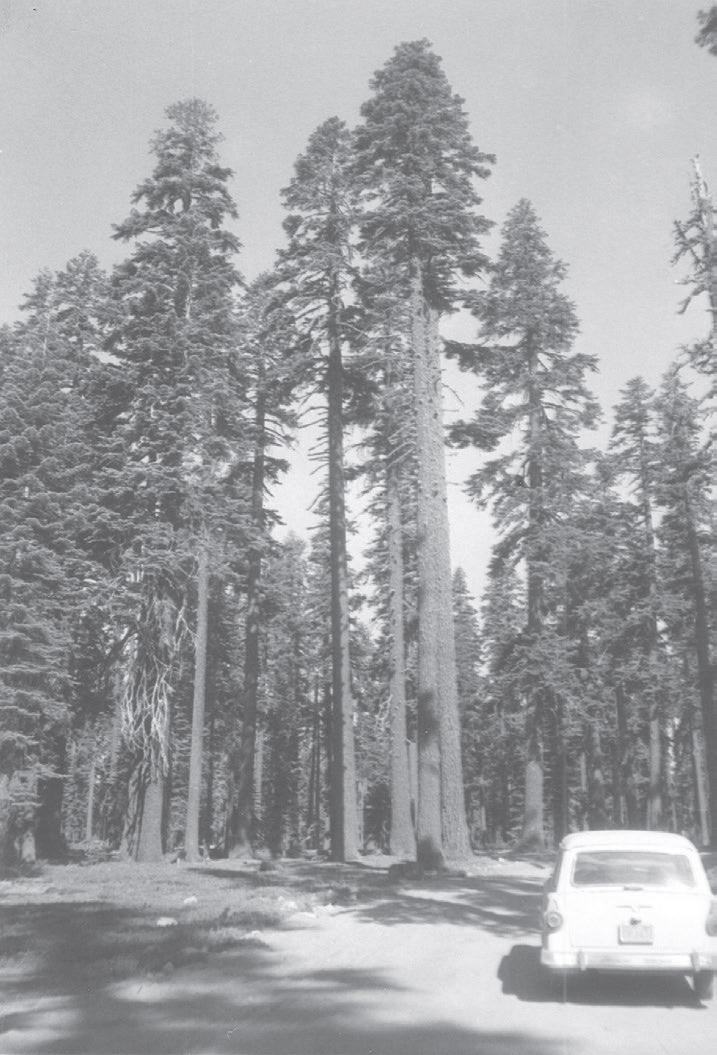
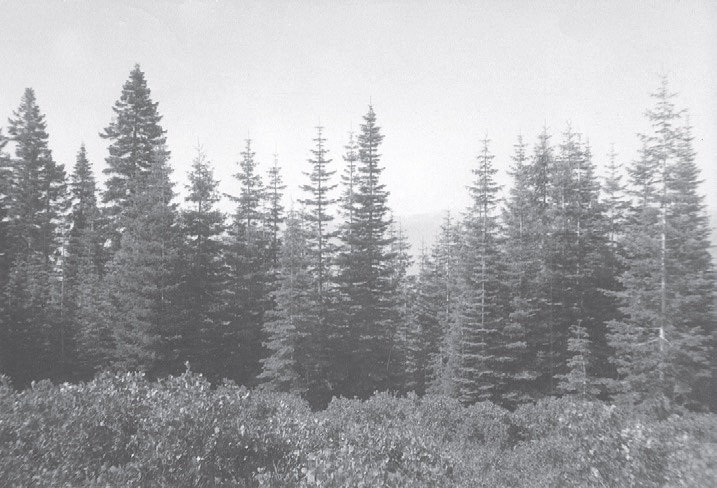
Mexican refuge
Ib was aware that Mexico had acted as a refuge for forest tree species that were driven south in the last ice age, so he went to Mexico to collect seed. The Mexican collections of Abies comprised A. religiosa and A. vejari. Abies religiosa is thought to be so named because the upper whorl of branches on the leader forms a perfect representation of the Christian cross. However its greatest distinction is that it hosts the annual migration of monarch butterflies from Canada to Mexico. There are photographs showing hundred of thousands of butterflies on a single tree.
Ib enlisted the help of John Miller, Eric Appleton and John Carruthers to raise plants from the seed and establish a series of species and provenance trials throughout New Zealand between 1957 and 1968. This article focuses on the Abies species and provenance trials which were usually adjacent to provenance trials of Douglas fir, with sitka spruce, western hemlock and other promising species nearby.
Trial layouts
Nine Abies species were tested across 19 sites, with uneven distribution of species across these sites. The species were −
- A.religiosa sacred or oyamel fir from Mexico
- A. concolor white fir
- A. grandis grand fir
- A. magnifica
- A. firma momi fir from Japan,
- A. nordmanniana Caucasian fir
- A. vejari silver fir
- A. bracteata bristlecone fir
- A. procera.
Trial layouts featured large blocks of 100 to 144 trees for each seedlot. Early growth was monitored by site inspections but the comments were universally discouraging. Growth was very slow and reports of yellowed foliage and dying trees were common. Many sites were abandoned as being unlikely to form stands by age 15. It is believed that lack of the appropriate mycorrhiza is a probable cause of the failure of many of these species.
After the universally slow start over all trial sites, the Abies species were pretty well forgotten until around age 30, when casual inspections revealed that their status had changed dramatically. What had been chlorotic trees lagging well behind Douglas fir had become much healthier than the Douglas fir and were adding a lot of volume.
This was particularly noticeable at Gwavas where the two trials were both thinned at the same time and the A. grandis had been pruned to six metres. A check on foliage retention revealed that while the Abies carried 10 years of living foliage, Douglas fir had only between two and three years of foliage. The foliage loss by Douglas fir was attributed to the swiss needlecast fungus Phaeocryptopus guaemanni, to which A. grandis appeared to be immune.
Most of these species were also disappointing in their growth and survival. There were two that showed promise, A. grandis and A. concolor. This article concentrates on the potential of these two firs.
Assessments
Four sites that appeared to be doing well were assessed for diameter at breast height in 2007. Rankleburn was included even when the site had been abandoned in 1974. The first site to be assessed was Gwavas where the A. grandis trial had been thinned to between 400 and 600 stems per hectare to correct for patchy stocking following a difficult establishment phase. The A. grandis was growing spectacularly well and A. concolor reasonably well.
| Abies trial sites which were assessed | |||||
|---|---|---|---|---|---|
| Site | Latitude | Longitude | Altitude metres | Mean temp °C | Annual rainfall mm |
| Long Mile | 38° 09 | 176° 16 | 300 | 12.5 | 1500 |
| Gwavas | 39° 42 | 176° 24 | 500 | 10.9 | 1523 |
| Hanmer | 42° 30 | 172° 48 | 500 | 7.8 | 1326 |
| Rankleburn | 46° 00 | 169° 12 | 168 | 9.7 | 906 |
Assessments showed that some species had more than 2,400 living stems per hectare, but these overstocked stands did not produce the greatest volumes. Gwavas was the best of the A. grandis sites with standing volumes of around
1,500 cubic metres per hectare at age 47 and a mean annual increment of 30 cubic metres. This compares with the adjacent 1959 Douglas fir provenance trial which had an average mean annual increment of 19 cubic metres for the 20 best provenances with the best at 27 cubic metres.
All species were assessed, but some species were at a disadvantage. The A. procera, A. magnifica and A. bracteata were in decline, with dominant trees dying every year. The A. vejari had been planted among redwoods and growth was affected, although the trees were healthy. The A. firma was represented by few trees and was not in the same class as A. grandis and A. concolor. The A. nordmanniana was represented by a single New Zealand seedlot from an arboretum and appeared to have inbreeding issues.
Grand fir Abies grandis
| Abies grandis seedlots in the 1959 provenance trial | ||||
|---|---|---|---|---|
| Seedlot | Provenance | Latitude | Longitude | Altitude metres |
| FRI 56/723 | Ophir, OR | 42° 39' | 124° 24' | 130 |
| FRI 56/724 | Blue Lake, CA | 40° 55' | 123° 50' | 650 |
| FRI 56/725 | Dehaven, CA | 39° 39' | 123° 45' | 175 |
| FRI 56/726 | Mendocino, CA | 39° 19' | 123° 48' | 50 |
| FRI 54/378 | Hanmer, NZ | |||
| FRI 54/457 | Vancouver Island, Canada | 49° 50' | 125° 25' | 45 |
| S54/541 | Queenstown Gardens, NZ | |||
| FRI 55/501 | Camano Is, WA | 48° 15' | 122° 40' | 150 |
| FRI 55/502 | Leaburg, OR | 43° 45' | 122° 30' | 250 |
Volume growth by provenance and site for A. grandis
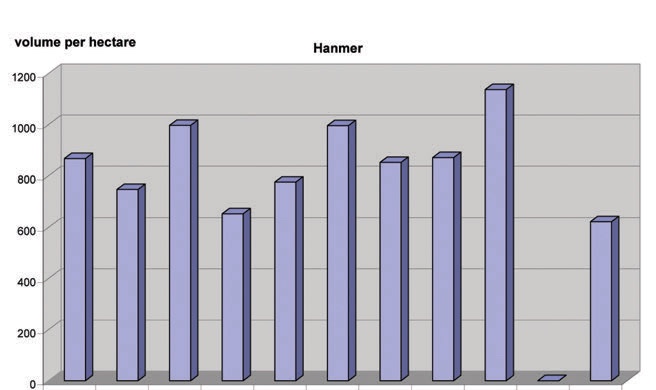
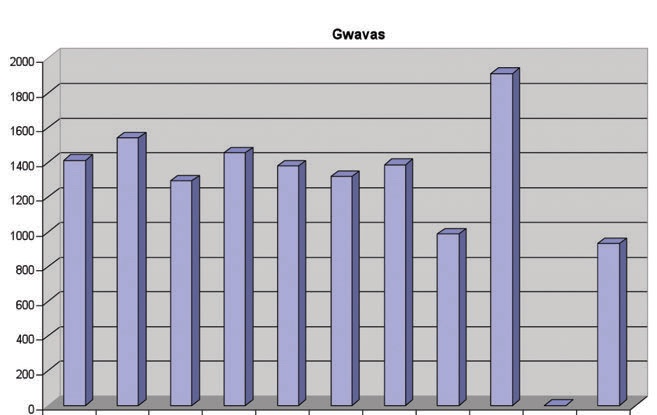
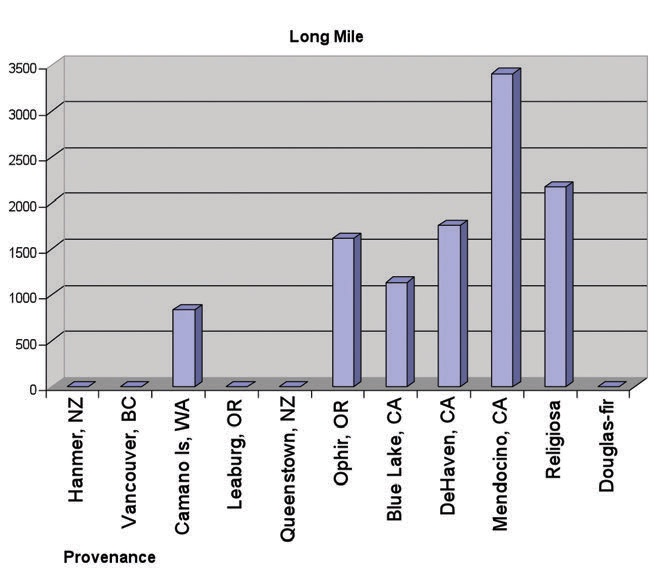
Abies grandis was planted with up to nine seedlots on 19 sites in 1959. This fir species was expected to be the best adapted and fastest growing of the various species and this was confirmed by the 2007 assessment.
The Gwavas site had been thinned to 400 stems a hectare in 1981 and this helped the trees reach diameters of over 80 cm for the best trees. Provenance differences were obscured by differences in stocking rate as 400 stems was evidently lower than the ideal stocking for a species with such good foliage health and shade tolerance. A count of green needles on some branches of edge trees showed that foliage could be retained for 10 years, while three years of foliage was the best observed on the neighbouring Douglas fir.
Mean annual increment was impressive at around 30 cubic metres per hectare each year. Current annual increment would be much higher again, as the trees got away to a very slow start and hardly grew for the first 10 years. A recent assessment of the neighbouring Douglas fir provenance trial returned a mean annual increment of 27 for the best provenance and 19 for the top 20 provenances.
The Mendocino provenance was expected to be amongst the best as it was from the mildest climate, but the extreme growth shown here would have been boosted by the high stocking of 550 stems per hectare. The second ranked provenance was rather surprisingly from Vancouver Island, which also had a higher stocking of 600 stems per hectare.
The provenance that appeared to have the worst volume was the provenance from Dehaven, but this was a result of very low stocking of 250 stems per hectare. Several provenances grew better than both of the New Zealand seedlots. The strong latitudinal trend for growth rate shown by sitka spruce or Douglas fir in New Zealand was not apparent.
Slow start
The A. grandis trial at Hanmer also started slowly, with a number of file notes documenting slow early growth. Unfortunately the Hanmer trial was not thinned, so the stocking was still very high at 1,500 to 2,000 stems a hectare. As a result there were many suppressed trees and even maximum diameters were well down on those at Gwavas. Once again the Mendocino provenance appeared to be the best at Hanmer, but there was no clear pattern of growth being influenced by latitude.
The Long Mile site was planted as 11-tree rows for demonstration purposes. It received a thinning to a good stocking between 550 and 1,200 stems per hectare. Unfortunately, no New Zealand seedlots were planted in the Long Mile, but the growth of the Mendocino provenance was outstanding.
The Rankleburn site suffered from browsing and was reduced to such a low stocking that significant Douglas fir regeneration was able to get away early in the life of the trial. It was thinned about four years before being assessed and a number of Douglas fir trees were retained in every plot.
White fir Abies concolor
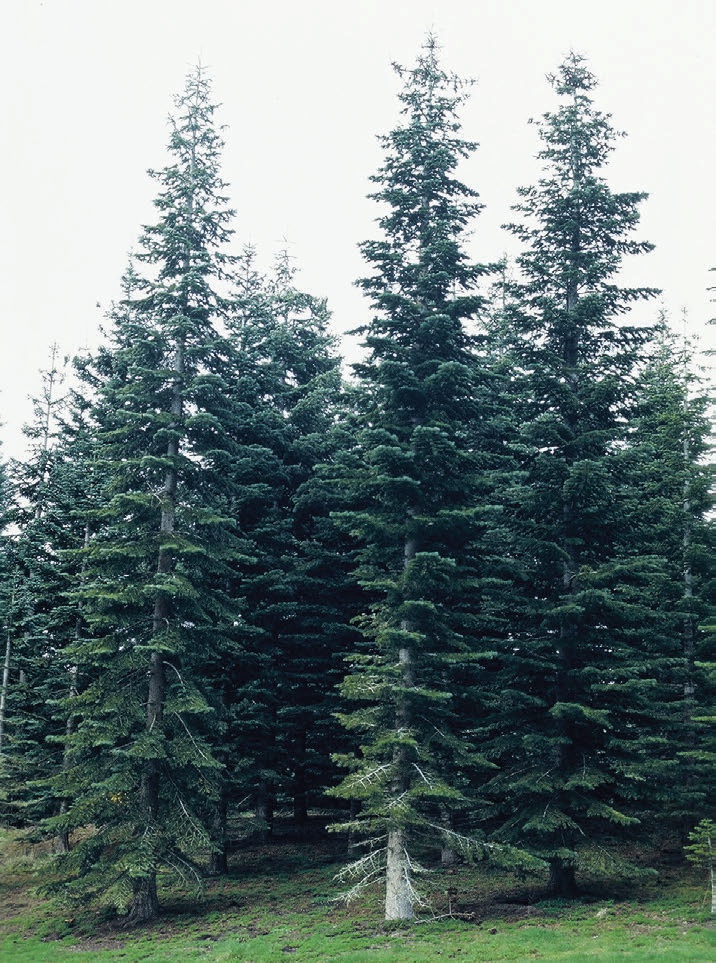
| Description of seedlots used in the 1959 A. concolor trial | ||||
|---|---|---|---|---|
| Seedlot | Provenance | Latitude | Longitude | Altitude metres |
| FRI 55/507 | Sierra, CA | 37° 01' | 119° 10' | 1800 |
| FRI 56/600 | Nevada, CA | 39° 15' | 120° 52' | 1700 |
| FRI 56/727 | Mt Hood , OR | 45° 08' | 121° 38' | 1025 |
| FRI 56/728 | Crater Lake, OR | 42° 46' | 121° 59' | 1575 |
| FRI 56/729 | Klamath , OR | 41° 53' | 122° 12' | 1360 |
| FRI 56/730 | Lassen, CA | 40° 07' | 121° 29' | 1300 |
| FRI 56/731 | Mendocino, CA | 39° 44' | 122° 51' | 1870 |
| FRI 56/732 | Eldorado, CA | 38° 44' | 120° 10' | 1970 |
| FRI 56/733 | Eldorado, CA | 38° 38' | 120° 31' | 1430 |
| FRI 56/734 | Sequoia, CA | 36° 07' | 118° 31' | 1970 |
| S56/538 | Queenstown Gardens, NZ | |||
Volume growth by provenance and site for A. concolor
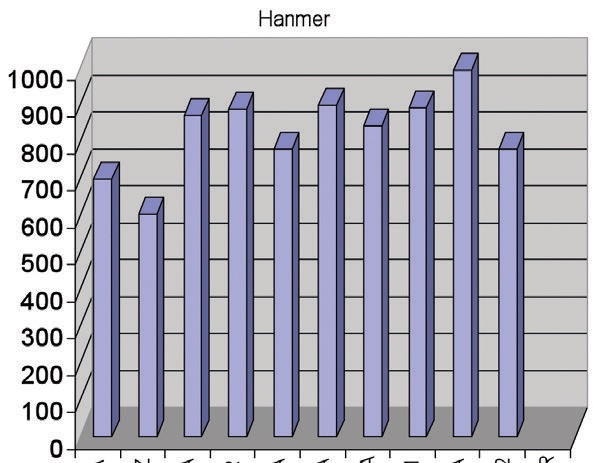
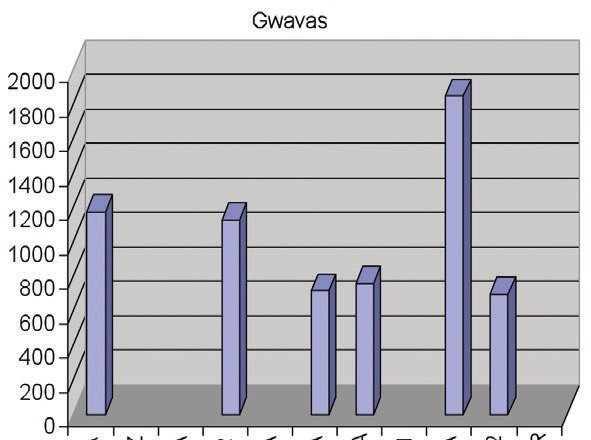
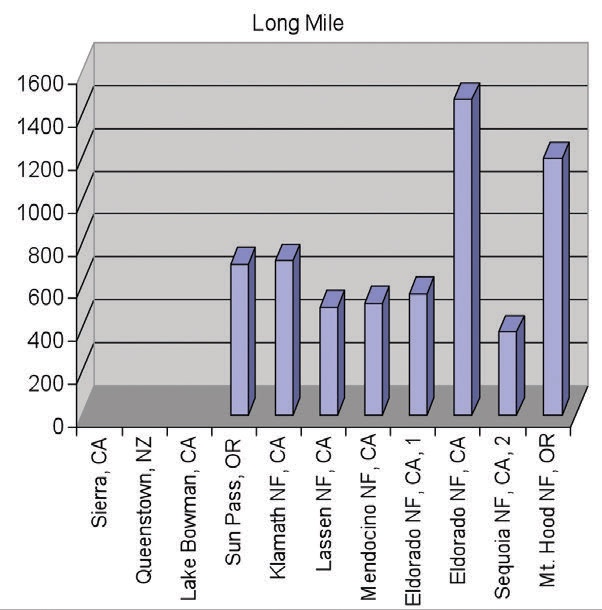
Abies concolor grows on sites of higher elevation than A. grandis, but can sometimes hybridise. Therefore we would expect rather slower growth rates than A. grandis on the same, relatively low elevation sites and this appeared to be the case on all sites. The trial design featured smaller 36-tree plots with more replication than the A. grandis plots. The Rankleburn site was not assessed as there had been regeneration from A. grandis, Douglas fir had been blanked into the plots and the thinning had favoured the wrong species.
One seedlot from Eldorado has growth very much better than the rest of the seedlots on all sites and fairly similar to A. grandis seedlots on the same site, even where both species have had different silviculture. It was possible that this seedlot may have contained a proportion of hybrids. Both heights and diameters were less than A. grandis, but stocking rates were high and it appeared that A. concolor could sustain much higher stocking than most species.
Conclusions
Abies grandis and A. concolor have proved to be capable of high rates of volume growth in New Zealand conditions. These species enjoy exceptional foliage health, which may make them more shade tolerant than Douglas fir. Abies grandis was capable of better volume growth rates than Douglas fir in spite of a protracted establishment phase. It would be wise to note the positive response of the trees to an application of fertiliser and duff to the A. grandis trial at Hanmer in any future establishment of A. grandis. Both species had good form, with straight stems, regular branching and few forks.
The best provenance of A. grandis was from Mendocino county in California, but the trend of increasing growth rate with more southerly latitudes that has been observed in New Zealand-grown Douglas-fir was not seen here.
The provenance of A. concolor which was the consistent the winner on all sites was seedlot from Eldorado national forest in California. The outstanding volume growth suggested that this seedlot may be a hybrid between A. concolor and A. grandis as this seedlot was collected at a relatively low elevation and may have been collected in the intermediate zone.
The trials of A. magnifica and A. procera established successfully and appeared in excellent health for several decades. However, they are now in decline, with several dominant trees dying every year, the most likely cause being some sort of root rot. As they are high altitude species, and the New Zealand trials were planted at low altitude, the most likely explanation was that they have not evolved to cope with soil fungi found on mild sites.
The foliage health of these Abies species was far superior to that of Douglas fir in adjacent stands. A future role of Abies grandis may be in mixture with Douglas fir as it is in natural forests in the Pacific northwest. The Douglas fir would establish well and draw the A. grandis up, then the A. grandis would buffer the transmission of Phaeocryptopus spores between the Douglas fir trees.
The most important role of these trials has been to identify the best seed source for any future plantings.The New Zealand seed sources are inferior, even though they have had an extra generation in which to adapt to the conditions.

 Farm Forestry New Zealand
Farm Forestry New Zealand
One post
Post from Eric Appleton on September 27, 2019 at 10:05AM
I joined Ib Thulin at FRI in July 1957 as a Research Technician in the Provenance and Tree Breeding section of FRI, moving to South Otago in February 1958 to layout, supervise planting and maintenance of provenance trials from Hanmer to Southland. I stayed until August 1960 and laid out the Hanmer Abies plots, to be planted a year later. I knew Egan Larson when I worked at FRI, I believe he was killed in a car accident.
I had opportunity in 2010 to briefly visit the Rankleburn Douglas fir provenance trial with the Douglas fir symposium held in Gore, the growth was very impressive 52 years after planting. On the way back to Nelson I briefly called at Naseby to see some of the provenance trials. There was seedling regeneration of Abies grandis under Pinus pinaster, and there were bunches of cones on the ground blown down by the NW winds, but time did not allow to find the Abies plots unfortunately.
Hanmer has massive scattered Abies grandis on the track at the top of High Street, part way up Conical Hill. They are larger than any other species in this mixed planting dating from about 1900. They only regenerate in considerable shade in the vicinity of the parent trees.
In Hanmer in 1958 there was a very promising understorey planted with Abies grandis under production thinned Larix decidua, then about 3-4m in height. I often wondered what happen to that stand. The Abies appeared to be very even in height and growth, obviously benefitting from the larch mycorrhizal fungi.
I visited Hanmer about 3 years ago and found the Abies concolor provenance trial and was surprised at the considerable height and heavy stocking with no thinning. I wish there were Abies grandis nearby to compare.
Douglas fir which were planted through the adjacent failed Abies plots in the late ‘60’s had been logged leaving the Abies concolor exposed to the elements.
I feel any trialling of Abies should be done on cut over Pinus radiata or other thriving conifer sites to ensure the right fungi are in place.
In the nursery Abies religiosa is the fastest grower, closely followed by Abies vejari.
Abies religiosa in Isel Park, Stoke as a solitary tree has outgrown all other trees in height, presumably from a 1960’s planting. The form is superb. Abies religiosa has been frosted at Wakefield as a 1 year old plant in the cold winters we used to get. A. vejari appears more winter cold hardy. We have two tall Abies vejari on a river flat at the nursery, coning regularly about 40 years of age. There are three Abies religiosa on the nursery site, widely separated, so the seed is less viable.
Abies grandis as a nursery plant is slower than the Mexican species, averaging 10-15cm at 1/0.
Abies spectabilis, a Himalayan species has grown to a very large size at the old Wanaka homestead site (now a park) and has withstood a lot of NW gales. We have seeding trees in our arboretum and produce planting stock which are very thick and sturdy.
We have Abies procera (syn A. nobilis) planted in the our Arboretum in hill country East of Wakefield, producing cones but no viable seed. The European Abies are represented, growing healthily, but slower than the Mexican species.
There is a very large Abies nordmanniana near Tapawera, inland from Nelson, growing over sheep yards, benefitting from regular fertilising.
Abies bracteata from California proved very prone to root rots in the nursery. A nursery regime to increase production of Abies species should include increasing the conifer mycorrhizal population in the soil, or growing in inoculated bark mixes in air root pruning cells. Nursery stock does not enjoy hard root pruning.
Add a post